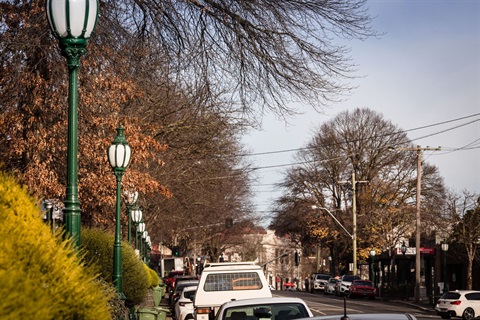Newark, DE Most ornamental crops can be classified as long-day, short-day, or day-neutral plants based on their flowering responses to the photoperiod (which is the day length), or the skotoperiod (which is the night length). Chrysanthemum is a common ornamental crop with an obligate short-day flowering response and only flowers when the night length is consistently longer than a critical duration.
Manipulation of the night length allows greenhouse growers to control flowering time precisely. In summer-fall garden chrysanthemum production, growers can use opaque black cloth to truncate the natural day length and lengthen the night length, thereby inducing flowering under otherwise long days. Another method is extending a short day with moderate blue [B (400-500 nm)] light. This inhibits flowering in greenhouse conditions with sunlight but not indoors (without sunlight) under B + red [R (600-700 nm)] light or white light.
We postulated that the contrasting responses to B light as a day extension depended on far-red [FR (700-800 nm)] light during the day, which is plentiful under sunlight but lacking indoors under B+R or white light-emitting diodes, whereas green [G (500-600 nm)] during the day would not play a role. To study this response in three chrysanthemum cultivars, we delivered indoor lighting treatments at two locations with an 11-hour main photoperiod of B60R120 B60G60R60, or B60R60, Fr60 light. Subscript values indicate the light intensity of each waveband (inµmol·m −2 ·s −1 ). After each short main photoperiod, plants received 0 or 4 hours of day-extension lighting of B light (B60).
In this study, all chrysanthemum cultivars showed flowering and morphological adaptations to lighting treatments. Leaf node number at flowering was proportional to flowering time for ‘Gigi Gold’ and ‘Gigi Yellow’, indicating that photon spectra did not influence the leaf development rate. In this study, under all treatments except B60 R60FR60 with day-extension B60, it took ‘Chelsey Pink’, ‘Gigi Gold’, and ‘Gigi Yellow’ 13 to 17 days to reach the first visible inflorescence and 42 to 51 days to the first open flower. In contrast, plants grown under B60R60FR60 with day-extension B60 took 41 to 67 days to reach the first visible inflorescence with few plants developing open flowers. Plants were tallest at the first open flower and after 9 weeks of treatments when grown under B60R60FR60 with day-extension B60. These results indicate that the inclusion of FR light, but not G light, in the main photoperiod is necessary for day-extension B light to inhibit flowering in chrysanthemum.
In conclusion, floral inhibition of chrysanthemum by day-extension B light requires the inclusion of FR light in a short main photoperiod of B+R light. Without FR light in the daytime light spectrum, chrysanthemum cannot perceive subsequent B light as an effective long-day signal. In contrast, G light during the day did not influence photoperiodic control of flowering by B light. These results can reconcile discrepancies in previous chrysanthemum studies, in which the effects of day-extension or night-interruption B light on flowering depended on the preceding light conditions. Although we cannot exclude possible roles of cryptochromes, phytochromes are likely involved in long-day signaling perception of B light based on daytime R/FR reversibility of flowering responses, which requires further research to elucidate.
Annika E. Kohler, Eva M. Birtell, Erik S. Runkle, and Qingwu Meng were involved in this collaborative research between the University of Delaware and Michigan State University. According to Dr. Wang, “A desire to bridge the discrepancies of chrysanthemum flowering under different light quality conditions promoted this collaboration.”
Dr. Meng is Assistant Professor of Controlled Environment Horticulture, Department of Plant and Soil Sciences, University of Delaware.
The full article can be found on the Journal of the American Society for Horticultural Science electronic journal website at:https://doi.org/10.21273/JASHS05294-23
Established in 1903, the American Society for Horticultural Science is recognized around the world as one of the most respected and influential professional societies for horticultural scientists. ASHS is committed to promoting and encouraging national and international interest in scientific research and education in all branches of horticulture.
Comprised of thousands of members worldwide, ASHS represents a broad cross-section of the horticultural community-scientists, educators, students, landscape and turf managers, government, extension agents and industry professionals. ASHS members focus on practices and problems in horticulture: breeding, propagation, production and management, harvesting, handling and storage, processing, marketing and use of horticultural plants and products. To learn more, visit ashs.org








